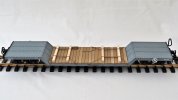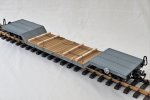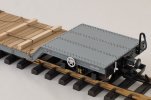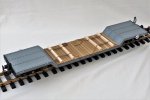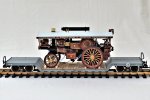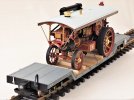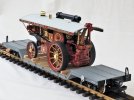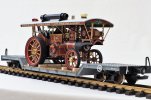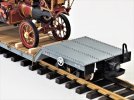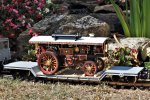David1226
Registered
Part 1 0f 2
Throughout the assembly of the items that have gone together to create the Claptowte Railway, I always had a clear idea of the look that I wanted to achieve and have always collected with those objectives in mind. Over the years, I have avoided the temptation to make any impulse purchases that did not fit in with my plan. That was until the Saturday, in February 2019, that I attended the G Scale Society West Midlands Branch’s annual exhibition, in Solihull, where on a trade stand, I saw and fell in love with a Midsummer Models Limited Edition 1/24th scale Burrell Scenic Showman's Engine, No 3896 'Earl Beatty'. It is number 576 on a limited run of 999.
As I stood there, drooling, my wife said ‘Oh go on, treat yourself’. Never being one to shun an opportunity, the purchase was made. In those days, the planned track plan for the Claptowte Railway was an end to end, fiddle yard to terminus. I had no real idea of what I was going to do with this model other than a vague notion that it would be placed on the layout in some cameo role. In the meantime, it is proudly displayed in an acrylic case on the lounge bay window.
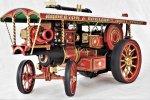
Having, through necessity, had to redraw the track plan into a tail chaser, and still unsure how best to display this superb model, I had a light-bulb moment, and realised that the perfect way to display the model on the railway, would be as a wagon load. That was going to require a suitable wagon, a large bogie well wagon.
Having looked at commercially produced models, with a view to adapting one to suit my freelance ‘Anglicised’ railway, it was apparent that there were none with an appropriately sized load-bed to suit my needs, or more precisely, suit the traction engine. The only way forward was to scratch build my own. Up until this time, all of the goods carrying wagons on the Claptowte Railway have been 4-wheelers, based on modified LGB Toy Train items. This new wagon would be a radical departure.
I acquired a pair of LGB US Freight Stock Bogies, I already had the wheels, bright nickel plated solid turned brass from Al Kramer in the US. These wheels are standard across all Claptowte Railway rolling stock, being really heavy, they give the models a very low centre of gravity. For the structural body, I bought an off-cut of 6mm MDF and had it cut to 100mm width. I purchased some 5/16” (7.8mm) plastic channel, to glue along the sides of the wagon. All of the other materials were ‘in stock’ or from the spares box.
Construction commenced with the cutting of the MDF into suitable lengths and angles to form the main body of the wagon.
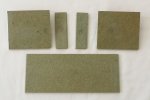
The parts were glued together to form the carcase of the body. The underside of the joints were reinforced by brass strip, bent to profile, and glued to the underside. Mounting plates, from plasticard, were glued on and drilled to accept plastic tube for the bogie pivots.
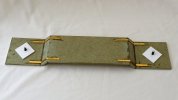
The bogies had to be modified by gluing a double thickness of 3mm plasticard across the top surface, in order to raise the ride height to the correct level.

A couple of plasticard washers were shaped from off-cuts, to secure the bogies to the pivots, with a screw.
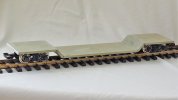
Having created a rolling carcase, I then had to dress it up by cladding it in plasticard. The first to be applied was the plastic channel which was cut and glued to the sides. The top surfaces of the wagon ends were clad in 1.00mm plasticard. The buffer beams were made from 2.0mm plasticard. The load area in the well of the wagon is a single piece of 3.0mm plasticard, scribed to represent wooden planking. Rivet heads were represented by self adhesive (yes, they do not always stick on their own) 1.0mm craft/nail art half pearls. I have never considered myself to be a ‘rivet counter’, but for those interested, there are 602.
The buffer heads and brake pipes were from the spares box, having been saved from the conversions of various Toy train items. The buffer beams were also fitted with Garden Railway Specialists (GRS) etched brass lamp irons, with dress making pins to represent bolt heads. The brake wheels were salvaged from the previous conversion of a LGB Jackson Sharp coach.
Plasticard strips were inserted vertically into the channel, spaced along the side of the well. These were drilled and loops of brass wire were glued in to provide lashing points.
That completes the construction of the wagon.
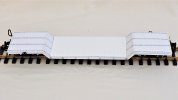
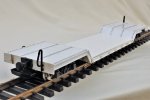
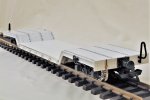
The finished wagon, out of the paint shop.
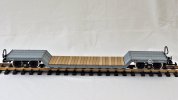
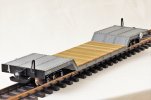

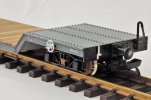
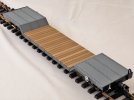
David
Throughout the assembly of the items that have gone together to create the Claptowte Railway, I always had a clear idea of the look that I wanted to achieve and have always collected with those objectives in mind. Over the years, I have avoided the temptation to make any impulse purchases that did not fit in with my plan. That was until the Saturday, in February 2019, that I attended the G Scale Society West Midlands Branch’s annual exhibition, in Solihull, where on a trade stand, I saw and fell in love with a Midsummer Models Limited Edition 1/24th scale Burrell Scenic Showman's Engine, No 3896 'Earl Beatty'. It is number 576 on a limited run of 999.
As I stood there, drooling, my wife said ‘Oh go on, treat yourself’. Never being one to shun an opportunity, the purchase was made. In those days, the planned track plan for the Claptowte Railway was an end to end, fiddle yard to terminus. I had no real idea of what I was going to do with this model other than a vague notion that it would be placed on the layout in some cameo role. In the meantime, it is proudly displayed in an acrylic case on the lounge bay window.

Having, through necessity, had to redraw the track plan into a tail chaser, and still unsure how best to display this superb model, I had a light-bulb moment, and realised that the perfect way to display the model on the railway, would be as a wagon load. That was going to require a suitable wagon, a large bogie well wagon.
Having looked at commercially produced models, with a view to adapting one to suit my freelance ‘Anglicised’ railway, it was apparent that there were none with an appropriately sized load-bed to suit my needs, or more precisely, suit the traction engine. The only way forward was to scratch build my own. Up until this time, all of the goods carrying wagons on the Claptowte Railway have been 4-wheelers, based on modified LGB Toy Train items. This new wagon would be a radical departure.
I acquired a pair of LGB US Freight Stock Bogies, I already had the wheels, bright nickel plated solid turned brass from Al Kramer in the US. These wheels are standard across all Claptowte Railway rolling stock, being really heavy, they give the models a very low centre of gravity. For the structural body, I bought an off-cut of 6mm MDF and had it cut to 100mm width. I purchased some 5/16” (7.8mm) plastic channel, to glue along the sides of the wagon. All of the other materials were ‘in stock’ or from the spares box.
Construction commenced with the cutting of the MDF into suitable lengths and angles to form the main body of the wagon.

The parts were glued together to form the carcase of the body. The underside of the joints were reinforced by brass strip, bent to profile, and glued to the underside. Mounting plates, from plasticard, were glued on and drilled to accept plastic tube for the bogie pivots.

The bogies had to be modified by gluing a double thickness of 3mm plasticard across the top surface, in order to raise the ride height to the correct level.

A couple of plasticard washers were shaped from off-cuts, to secure the bogies to the pivots, with a screw.

Having created a rolling carcase, I then had to dress it up by cladding it in plasticard. The first to be applied was the plastic channel which was cut and glued to the sides. The top surfaces of the wagon ends were clad in 1.00mm plasticard. The buffer beams were made from 2.0mm plasticard. The load area in the well of the wagon is a single piece of 3.0mm plasticard, scribed to represent wooden planking. Rivet heads were represented by self adhesive (yes, they do not always stick on their own) 1.0mm craft/nail art half pearls. I have never considered myself to be a ‘rivet counter’, but for those interested, there are 602.
The buffer heads and brake pipes were from the spares box, having been saved from the conversions of various Toy train items. The buffer beams were also fitted with Garden Railway Specialists (GRS) etched brass lamp irons, with dress making pins to represent bolt heads. The brake wheels were salvaged from the previous conversion of a LGB Jackson Sharp coach.
Plasticard strips were inserted vertically into the channel, spaced along the side of the well. These were drilled and loops of brass wire were glued in to provide lashing points.
That completes the construction of the wagon.



The finished wagon, out of the paint shop.





David

